 Return to
Return toAviation Answer-Man
Gateway
 Return to
Return to
Aviation Answer-Man
Gateway
 Return to
Return to.
Chapter 5
The
deHavilland D.H.82 Tiger Moth
and the
Moth Family
Copyright 2000, 2001, 2002 by Richard Harris
All Rights Reserved
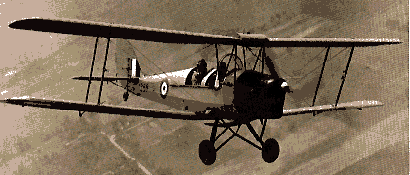
The Tiger Moth is vaguely descended from the DH-4 biplane bomber -- itself one of the 8 most important planes of all time (see above). After World War I, the DH-4's designer, Sir Geoffrey deHavilland, fumbled around trying to find something productive to do. His wartime military-airplane-designing talents no longer in demand, he looked for a chance to build civilian planes. His first job came building a custom biplane for a wealthy customer, who then offered to fund a civil airplane development. deHavilland readily agreed, and set about developing a lightweight, 2-seat biplane somewhat along the lines of the stout DH-4, but with a much smaller, more-affordable engine.
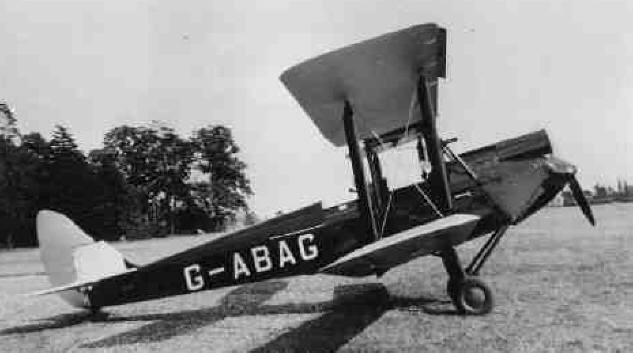 The first successful design was the DH-60 (shown at left), which he named the "Moth," because of its moth-like wings, designed so they could be folded back against the plane, so it could be towed home behind a car. The power was drawn from a light (300-pound) 4-cylinder engine, using half the cylinders of a war-surplus V-8 engine. The design was simple and effective, resulting in a well-behaved airplane that was affordable for most of Britain's well-heeled aristocracy and growing upper-class. Among Britain's elite in the wild 1920's (the "Roaring '20's"), it became a matter of status to engage in sport flying, and the Moth became the most popular vehicle for the activity.
The first successful design was the DH-60 (shown at left), which he named the "Moth," because of its moth-like wings, designed so they could be folded back against the plane, so it could be towed home behind a car. The power was drawn from a light (300-pound) 4-cylinder engine, using half the cylinders of a war-surplus V-8 engine. The design was simple and effective, resulting in a well-behaved airplane that was affordable for most of Britain's well-heeled aristocracy and growing upper-class. Among Britain's elite in the wild 1920's (the "Roaring '20's"), it became a matter of status to engage in sport flying, and the Moth became the most popular vehicle for the activity.
As the Moth's popularity grew, however, Geoffrey deHavilland used up the war-surplus engine supply, and had to design his own engine. deHavilland started by designing a racing engine of 135-hp engine, racing it until the bugs were worked out, then "de-rated" it (limited its power) to 100-hp to provide a durable, dependable engine for use in Moth biplanes. This new "Gypsy engine," when installed in the Moth, made a fine new plane -- the "Gypsy Moth" (shown at right, below). Capable of cruising at 100 miles per hour, it was blazingly fast for a cheap, light plane in 1929 -- yet reliable and very manageable.
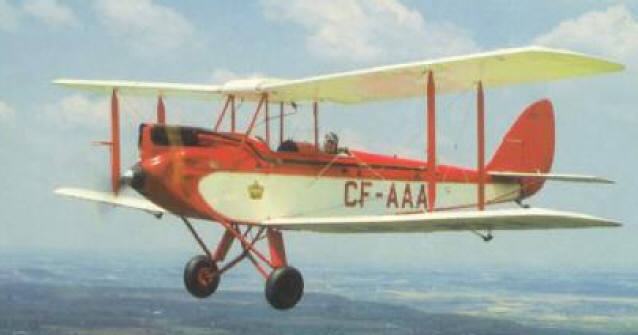 When the Prince of Wales (son of Britain's king, and heir to the throne) bought a Gypsy Moth, it became royally glamourous, and sales took off. The efficiency of mass-production enabed deHavilland to cut prices, down to only about $1,500 apiece. Almost overnight the stylish-but-affordable Gypsy Moth suddenly became the hottest aviation product in Britain -- and in the world.
When the Prince of Wales (son of Britain's king, and heir to the throne) bought a Gypsy Moth, it became royally glamourous, and sales took off. The efficiency of mass-production enabed deHavilland to cut prices, down to only about $1,500 apiece. Almost overnight the stylish-but-affordable Gypsy Moth suddenly became the hottest aviation product in Britain -- and in the world.
Over 1,000 Gypsy Moths were built in 1930, alone -- with three a day coming off the assembly line. By the end of 1930, with over 2,000 built, 85% of the civilian planes in Britain were Moths of one kind or another. Moths began to spread aviation (and set records) the world over. Gypsy Moth pilots boldly flew solo trans-continental and overwater flights, including to Australia -- and even across 1,500 miles of ocean to New Zealand. And it was a stout plane, too: American aviatrix Laura Ingalls flew her Moth through a record 344 loops in a row.
About this time, the Royal Air Force (RAF) was looking for a trainer plane, and the Gypsy Moth -- affordable, popular, fairly safe and efficient -- was a leading contender. Improvements followed. It became even more attractive when the engine cylinders, projecting up through the pilot's line of sight, were turned around and slung underneath the engine.
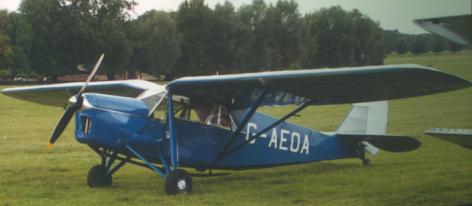 Mated to an enclosed, high-wing monoplane (much like an enlarged Piper Cub) the new "inverted" engine resulted in the "DH-80 Puss Moth" (shown at right) -- which improved further when its wood fuselage frame was replaced with metal tubing, providing a stouter plane.
Mated to an enclosed, high-wing monoplane (much like an enlarged Piper Cub) the new "inverted" engine resulted in the "DH-80 Puss Moth" (shown at right) -- which improved further when its wood fuselage frame was replaced with metal tubing, providing a stouter plane.
Metal framing was added to the DH60 Moth biplane, too, creating the "Metal Moth.". The ultimate DH60 Moth biplane was the "Moth Major" named for a new engine. DeHavilland strengthened the "Gypsy" engine to deliver 130 horsepower -- creating the "Gypsy Major" engine -- one of the most reliable engines of the 20th Century.
In an age when most airplane engines were cantankerous and prone to failure, the increasingly reliable deHavilland Gypsy engines powered record-breaking flights. In May 1930, British aviatrix Amy Johnson stunned the world by taking off and flying halfway around the world alone in her Gypsy Moth biplane from Britain to Darwin, Australia. She followed up by flying her Puss Moth monoplane from Britain to Japan in under 9 days. In 1932, her subsequent husband, Jim Mollison, would better Charles Lindbergh's transatlantic solo flight, by flying across the icy North Atlantic, west-to-east, against the westerly prevailing winds -- in a small-but-reliable, single-engine Puss Moth.
Safe, durable and reliable, deHavilland's Moths did much to make flying safe and practical. These reliable airplanes made aviation far more safe, sensible and socially-accepted -- and more affordable.
And there were implications for cheaper, mass-travel by air, too. The lessons learned in perfecting the Moths would eventually be applied to some of the world's first successful airliners -- by deHavilland.
As the numbers of Moths of every type grew, and their legendary reliability and durability seemed to steadily increase, it became increasingly clear that a Moth of some sort was the logical choice for the Royal Air Force's new training plane. But the RAF -- focused on the sturdier biplanes rather than monoplanes -- complained that the pilot could not quickly bail out of any Moth biplane, due to the overhead wing and the surrounding tangle of wires and struts. So deHavilland simply fixed the problem by moving the upper wing forward.
Execept it was not so simple.
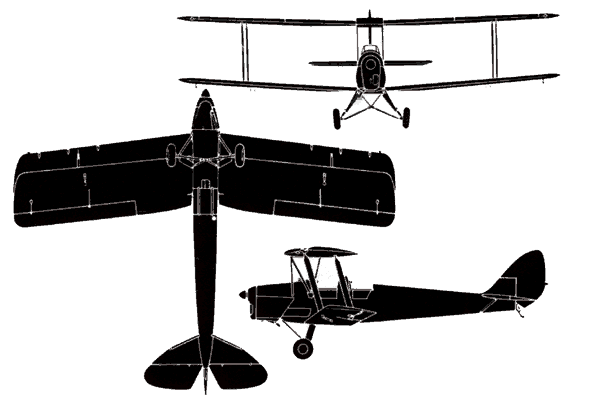 Of course, moving the wings forward meant that the plane was now no longer balanced properly, with the wings' "center of lift" now ahead of the airplane's "center of gravity" (center of weight). To move the center of lift back in place, deHavilland swept back the wings at an angle (like a modern-day jet fighter), leaving the pilot's overhead clearance uncluttered, but moving the wings' center-of-lift back where it belonged.
Of course, moving the wings forward meant that the plane was now no longer balanced properly, with the wings' "center of lift" now ahead of the airplane's "center of gravity" (center of weight). To move the center of lift back in place, deHavilland swept back the wings at an angle (like a modern-day jet fighter), leaving the pilot's overhead clearance uncluttered, but moving the wings' center-of-lift back where it belonged.
The sweepback caused the lower wingtips to touch the ground when the plane had a bumpy landing, so the lower wings were angled upwards slighty ("dihedral" was increased) to clear the ground. The combined result of Gypsy Major engine, wing sweepback and increased dihedral yielded a distinctively different airplane, with suprisingly better handling characteristics and pilot visibility: the classic DH-82 Tiger Moth.
 Stable, safe, dependable and sturdy -- but cheap -- the Tiger Moth was a good choice for a military training plane. To be sure, the Tiger Moth (shown at right) was still a handful for novice pilots, requiring some real development of piloting skill; but it was not utterly unforgiving like many of the planes of the day. These factors all combined to make the Tiger Moth the RAF's choice for a military trainer plane, and hundreds more were bought for government-sponsored civilian flying clubs. In the years leading up to World War II, thousands of Tiger Moths were put to work training the pilots who would eventually save Britain from Hitler and halt the Nazi advance.
Stable, safe, dependable and sturdy -- but cheap -- the Tiger Moth was a good choice for a military training plane. To be sure, the Tiger Moth (shown at right) was still a handful for novice pilots, requiring some real development of piloting skill; but it was not utterly unforgiving like many of the planes of the day. These factors all combined to make the Tiger Moth the RAF's choice for a military trainer plane, and hundreds more were bought for government-sponsored civilian flying clubs. In the years leading up to World War II, thousands of Tiger Moths were put to work training the pilots who would eventually save Britain from Hitler and halt the Nazi advance.
Used extensively before, during, and after the Second World War, the Tiger Moth was one of the two most important and valuable training planes of all time -- training tens of thousands of the worlds' pilots (The other great trainer was the Piper Cub. In fact, as a wartime trainer, the Tiger Moth effectively surpassed the Piper Cub in longevity. While most of the Cub's primary training duties were taken over, during the war, by the Stearman PT-13/-17, Fairchild PT-19/-20, or Ryan PT-22, the Tiger Moth held on as the British Empire's chief primary trainer throughout the war)
Though most Tiger Moths were built in Britain, some were built under license in several other countries -- particularly in Canada. deHavilliand's tiny Canadian subsidiary, deHavilland of Canada, Ltd. -- in the process of building over a thousand of the Tiger Moths under license from its parent company -- had suddenly become a major aircraft manufacturer in its own right . This paved the way for the rise of deHavilland of Canada (later an independent company) to become a major military and commercial aircraft manufacturer and pre-eminient utility-plane designer -- becoming the first major Canadian aircraft manufacturer. The Tiger Moth established Canada as a major aircraft-producing country.
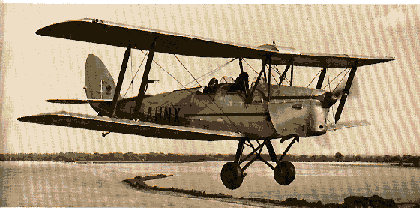 By the end of World War II, over 8,000 Tiger Moths had been built, and surplus models flooded the world market, training thousands of new pilots, and spreading light-plane aviation into every nook and cranny of the British Empire, and the world.
By the end of World War II, over 8,000 Tiger Moths had been built, and surplus models flooded the world market, training thousands of new pilots, and spreading light-plane aviation into every nook and cranny of the British Empire, and the world.
One of its most significant post-war missions took advantage of the Tiger Moth's ready availability, maneuverability and sturdiness: it helped shape the development of agricultural aviation, where its ready availability, rugged durabilty, nimble maneuverability, and good slow-speed handling made it popular for the challenging work of cropdusting.
The Tiger Moth's low cost, efficiency, fabulously reliable engine, and its deliberate design for rough landings (by students) on dirt/grass fields (almost the only kind when the 'Moth was made) made it better-suited (than most modern aircraft) to the harsh flying conditions in poor countries and remote parts of the world. For decades after its birth, the Tiger Moth continued to be an important aircraft in underdeveloped nations, bringing the benefits of aviation where modern aircraft dared not fly. Though none are less than a half-century old, it is estimated that -- even today -- hundreds of Moths of every type, are still flying all over the world.
Why this plane stands out from its "peers."
While many other planes have been important, few others had nearly so pivotal an impact on aviation or on history. The deHavilland Moths (particularly the Tiger Moth) are "indispensible" aircraft -- aircraft with no significant concievable substitute available at their time and place in history.
The deHavilland Moths brought safety and reliability to aviation as never before, and radically expanded personal and utility flying throughout the world.
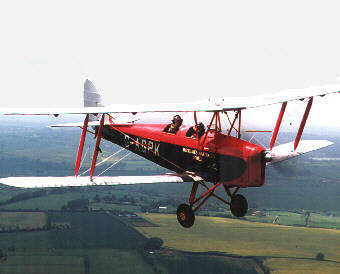 These airplanes simply outperformed, on meager reasoures, most of their competition, had a level of reliability unequalled in their day (thanks chiefly to the superb deHavilland Gypsy engines). They are the product of a prodigiously productive manufacturer, whose economy of mass production brought flying -- and its benefits -- within reach of a vastly greater number of people.
These airplanes simply outperformed, on meager reasoures, most of their competition, had a level of reliability unequalled in their day (thanks chiefly to the superb deHavilland Gypsy engines). They are the product of a prodigiously productive manufacturer, whose economy of mass production brought flying -- and its benefits -- within reach of a vastly greater number of people.
Other European planes were significant, including other deHavillands, but the Moth was the Europeans' attainable plane. Its efficiency, massive numbers, reliability and stout workmanship -- matched with respectable performance -- guaranteed it an important role in general aviation and military aviation, worldwide, for decades. And -- of course -- the affordable Tiger Moths were ready in sufficient numbers, in the late 1930's and early 1940's, to train the pilots needed to halt the deadly 20th-Century advance of facism.
No other planes in their time and place so thoroughly served the advance of aviation (and civilization) in so many diverse ways as the deHavilland Moths. Return to
Return to
 Return to
Return to
Aviation Answer-Man
Gateway